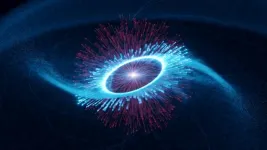(Press-News.org) A technology being studied to curb climate change – one that could be put in place in one or two decades if work on the technology began now – would affect food productivity in parts of planet Earth in dramatically different ways, benefiting some areas, and adversely affecting others, according to projections prepared by a Rutgers-led team of scientists.
Writing in the journal, Nature Food, the scientists described the results of computer models simulating varying climate scenarios and their impacts over time on the production of the world’s four major food crops: corn, rice, soybeans and wheat in all locations where they are grown.
Some scenarios were produced by simulated stratospheric aerosol intervention (SAI), also known as geoengineering, to halt or reverse climate change, while others, for comparison purposes, weren’t. The SAI scenario, inspired by volcanic eruptions, would involve spraying sulfur dioxide gas into the stratosphere. By placing a cloud of what becomes sulfuric acid in the upper atmosphere continuously, the process would shield the Earth from the Sun, cooling it.
“Not one of the 11 climate change or climate intervention scenarios we analyzed benefits everyone,” said Brendan Clark, a doctoral student in the Department of Environmental Sciences at the Rutgers School of Environmental and Biological Sciences (SEBS), and lead author on the study. “Nations may have different ideas of what constitutes an optimal global temperature, which could lead to conflicts. It would be like people fighting over the thermostat in a house, but on a global scale.”
The models showed marked differences in agricultural productivity depending on where a country is positioned on the globe. Continued, uncontrolled climate change, the models revealed, favors crop production in the cold, high-latitude areas, such as Canada, Russia, the U.S. northern border states, Scandinavia and Scotland.
Moderate amounts of atmospheric sulfur spraying, which may either halt or slightly lower global average temperatures, favors food production in the temperate regions known as the mid-latitudes, where most of the large land masses of North America and Eurasia are located, according to the analysis.
Large amounts of climate intervention to significantly reverse warming and lower the global average temperature would favor agricultural production in the tropics, the region of Earth around the equator. In the Western Hemisphere, the region includes Mexico, all of Central America, the Caribbean and the top half of South America. In the Eastern Hemisphere, the tropics include most of Africa, parts of the Middle East, most of India, all of Southeast Asia, most of Australia and most of the island nations of Oceania.
“Are we willing to live with all these potential impacts to have less global warming? That’s the question we’re trying to ask here,” said Alan Robock, a Distinguished Professor of Climate Science in the Department of Environmental Sciences at SEBS, and a co-author of the study. “We’re trying to quantify each of the potential risks and benefits so we can make informed decisions in the future.”
The team worked with scientists at the National Center for Atmospheric Research employing the federal laboratory’s computer model that calculates global climate and weather patterns. The model simulates atmospheric, land and oceanic climate change as well as crop growth. The work produced 11 different climate scenarios of a future Earth, eight of them formed by differing levels of climate intervention, producing different temperatures, rainfall, and sunlight, and different carbon dioxide emissions.
“Our results highlight the challenges in defining ‘globally optimal’ strategies,” said Lili Xia, an assistant research professor in the Department of Environmental Sciences at SEBS and a co-author of the study. “It’s very complicated and it’s hard to reach a conclusion, such as saying whether climate intervention is good or bad. I don’t know at what point people will reach a decision. But, for me, I feel like it’s almost impossible.”
Other scientists on the study included Sam Rabin, Simone Tilmes and Jadwiga Richter of the National Center for Atmospheric Research; and Daniele Visioni of Cornell University.
END
Climate intervention technologies may create winners and losers in world food supply
Analysis by scientists shows future techniques limiting global climate change may create uneven benefits, forcing difficult decisions worldwide
2023-10-05
ELSE PRESS RELEASES FROM THIS DATE:
Racial and ethnic disparities in glycemic control among insured adults
2023-10-05
About The Study: In this study of 4,070 insured adults with diabetes, disparities in poor glycemic control persisted despite adjustment for social, health care, and behavioral factors. Research is needed to identify the barriers contributing to poor control even in populations with access to care.
Authors: Sandra S. Albrecht, Ph.D., M.P.H., of the Columbia University Mailman School of Public Health in New York, is the corresponding author.
To access the embargoed study: Visit our For The Media website at this link https://media.jamanetwork.com/
(doi:10.1001/jamanetworkopen.2023.36307)
Editor’s Note: Please see the article ...
Changes in cannabis-attributable hospitalizations following nonmedical cannabis legalization in Canada
2023-10-05
About The Study: This study of 26.9 million individuals in four Canadian provinces found that cannabis legalization with restrictions was not associated with an increase in hospitalizations due to cannabis but commercialization was. The findings suggest that commercialization of cannabis may be associated with increases in cannabis-related health harms, including cannabis-induced psychosis.
Authors: Daniel T. Myran, M.D., M.P.H., of the Ottawa Hospital Research Institute in Ottawa, Ontario, Canada, is the corresponding author.
To ...
Generative AI for chest radiograph interpretation in the emergency department
2023-10-05
About The Study: In a representative sample of emergency department chest radiographs, results suggest that the generative artificial intelligence (AI) model produced reports of similar clinical accuracy and textual quality to radiologist reports while providing higher textual quality than teleradiologist reports. Implementation of the model in the clinical workflow could enable timely alerts to life-threatening pathology while aiding imaging interpretation and documentation.
Authors: Mozziyar Etemadi, M.D., Ph.D., of Northwestern Medicine ...
First epidemiological study links popular weight-loss drugs to stomach paralysis, other serious gastrointestinal conditions
2023-10-05
They’re being hailed as an effective way to lose weight, but diabetes drugs like Ozempic may come with a heightened risk of severe gastrointestinal problems.
That’s according to new research from the University of British Columbia showing that medications known as GLP-1 agonists—which includes brands like Wegovy, Ozempic, Rybelsus and Saxenda—are associated with an increased risk of serious medical conditions including stomach paralysis, pancreatitis and bowel obstruction.
While previous studies highlighted some of these risks in patients with diabetes, this is the first large, population-level study to examine adverse gastrointestinal ...
Human vascular organoids reveal clues for a potential COVID treatment
2023-10-05
When the new SARS-CoV-2 virus began killing thousands of people every week, physicians and scientists around the globe raced to learn why the new pathogen was so deadly. Among many early findings, experts noted that the infection played havoc with blood circulation, both inflaming the linings of blood vessels and making the blood itself more likely to form dangerous clots.
Critically ill COVID-19 patients suffered pulmonary embolisms, deep vein thrombosis (DVT), arterial thrombosis, as well as microvascular thrombosis affecting tissues of the lungs, kidneys, and heart.
Doctors tried a wide array of existing medications in hopes of controlling the blood system impacts, with mixed ...
New research sheds light on genetics of placenta growth and link to preeclampsia in mother
2023-10-05
New research has shed light on how genetics influences the growth of the placenta, revealing a link to risk of disease in the mother.
Scientists from the University of Exeter worked with colleagues in Norway and Denmark to lead a largescale international collaboration which examined placental growth in the greatest detail yet. They caried out the first ever genome-wide association study of the weight of the placenta at birth, generating a number of revelations. Among the findings published in Nature Genetics, the team concluded that faster growth of the placenta can contribute to risk of preeclampsia, and to earlier delivery ...
The medicine of the future could be artificial life forms
2023-10-05
Creating artificial life is a recurring theme in both science and popular literature, where it conjures images of creeping slime creatures with malevolent intentions or super-cute designer pets. At the same time, the question arises: What role should artificial life play in our environment here on Earth, where all life forms are created by nature and have their own place and purpose?
Associate professor Chenguang Lou from the Department of Physics, Chemistry, and Pharmacy, University of Southern Denmark, together with Professor Hanbin Mao from Kent State University, is the parent of a special artificial hybrid molecule that could lead to ...
Scientists discover the highest energy gamma-rays ever from a pulsar
2023-10-05
Scientists using the H.E.S.S. observatory in Namibia have detected the highest energy gamma rays ever from a dead star called a pulsar. The energy of these gamma rays clocked in at 20 tera-electronvolts, or about ten trillion times the energy of visible light. This observation is hard to reconcile with the theory of the production of such pulsed gamma rays, as the international team reports in the journal Nature Astronomy.
Pulsars are the left-over corpses of stars that spectacularly exploded in a supernova. The explosions leave behind ...
Discovery made by University of Warsaw scientists may enable network interface for quantum computers
2023-10-05
A team of scientists at the QOT Centre for Quantum Optical Technologies, including a student from the Faculty of Physics (University of Warsaw), made a device capable of the conversion of quantum information between microwave and optical photons. The results of research, published in “Nature Photonics” magazine, highlight a new microwave detection method with possible applications in quantum technologies, as a part of quantum network infrastructure, and in microwave radio-astronomy.
Conversion of quantum information
Whenever you listen to a song on your phone or computer, a conversion of information happens – ...
Risk of gastrointestinal adverse events associated with glucagon-like peptide-1 receptor agonists for weight loss
2023-10-05
About The Study: This study found that use of glucagon-like peptide-1 agonists for weight loss compared with use of bupropion-naltrexone was associated with increased risk of pancreatitis, gastroparesis, and bowel obstruction but not biliary disease. Given the wide use of these drugs, these adverse events, although rare, must be considered by patients who are contemplating using the drugs for weight loss because the risk-benefit calculus for this group might differ from that of those who use them for diabetes.
Authors: Mahyar Etminan, Pharm.D., M.Sc., of the University of British Columbia in Vancouver, is the corresponding author.
To access the embargoed study: Visit ...
LAST 30 PRESS RELEASES:
58% of patients affected by 2022 mpox outbreak report lasting physical symptoms
Golden Gate method enables rapid, fully-synthetic engineering of therapeutically relevant bacteriophages
Polar weather on Jupiter and Saturn hints at the planets’ interior details
Socio-environmental movements: key global guardians of biodiversity amid rising violence
Global warming and CO2 emissions 56 million years ago resulted in massive forest fires and soil erosion
Hidden order in quantum chaos: the pseudogap
Exploring why adapting to the environment is more difficult as people age
Society for Laboratory Automation and Screening welcomes new scientific director: Madeline M. Farley, Ph.D.
Austrian cow shows first case of flexible, multi-purpose tool use in cattle
Human nasal passages defend against the common cold and help determine how sick we get
Research alert: Spreading drug costs over the year may ease financial burden for Medicare cancer patients
Hospital partnership improves follow up scans, decreases long term risk after aortic repair
Layered hydrogen silicane for safe, lightweight, and energy-efficient hydrogen carrier
Observing positronium beam as a quantum matter wave for the first time
IEEE study investigates the effects of pointing error on quantum key distribution systems
Analyzing submerged fault structures to predict future earthquakes in Türkiye
Quantum ‘alchemy’ made feasible with excitons
‘Revoice’ device gives stroke patients their voice back
USF-led study: AI helps reveal global surge in floating algae
New method predicts asthma attacks up to five years in advance
Researchers publish first ever structural engineering manual for bamboo
National poll: Less than half of parents say swearing is never OK for kids
Decades of suffering: Long-term mental health outcomes of Kurdish chemical gas attacks
Interactional dynamics of self-assessment and advice in peer reflection on microteaching
When aging affects the young: Revealing the weight of caregiving on teenagers
Can Canada’s health systems handle increased demand during FIFA World Cup?
Autistic and non-autistic faces may “speak a different language” when expressing emotion
No clear evidence that cannabis-based medicines relieve chronic nerve pain
Pioneering second-order nonlinear vibrational nanoscopy for interfacial molecular systems beyond the diffraction limit
Bottleneck in hydrogen distribution jeopardises billions in clean energy
[Press-News.org] Climate intervention technologies may create winners and losers in world food supplyAnalysis by scientists shows future techniques limiting global climate change may create uneven benefits, forcing difficult decisions worldwide



